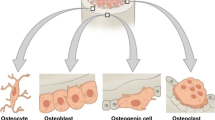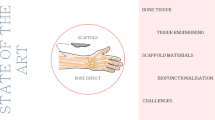Abstract
Ion doping is one of the most important methods to modify the properties of bioceramics for better biodegrade abilities, biomechanical properties, and biocompatibilities. This paper presents a novel ion doping method applied in calcium polyphosphate (CPP)-based bioceramic scaffolds substituted by potassium and strontium ions (K/Sr) to form (K/Sr–CPP) scaffolds for bone tissue regeneration. The microstructure and crystallization of the scaffolds were detected by scanning electron microscopy and X-ray diffraction. Compressive strength and degradation tests were assessed to evaluate the mechanical and chemical stabilities of K/Sr–CPP in vitro. The cell biocompatibility was measured with respect to the cytotoxicity of the extractions of scaffolds. Muscle pouches and bone implantation were performed to evaluate the biodegradability and osteoconductivity of the scaffolds. The results indicated that the obtained K/Sr–CPP scaffolds had a single beta-CPP phase. The unit cell volume and average grain size increased but the crystallization decreased after the ions were doped into the CPP structure. The K/Sr–CPP scaffolds yielded a higher compressive strength and a better degradation property than the pure CPP scaffold. The MTT assay and in vivo results reveal that the K/Sr–CPP scaffolds exhibited a better cell biocompatibility and a tissue biocompatibility than CPP and hydroxyapatite scaffolds. This study proves the potential applications of K/Sr–CPP scaffolds in bone repair.









Similar content being viewed by others
References
Pilliar RM, Filiaggi MJ, Wells JD, Grynpas MD, Kandel RA. Porous calcium polyphosphate scaffolds for bone substitute applications—in vitro characterization. Biomaterials. 2001;22:963–72.
Grynpas MD, Pilliar RM, Kandel RA, Renlund R, Filiaggi M, Dumitriu M. Porous calcium polyphosphate scaffolds for bone substitute applications in vivo studies. Biomaterials. 2002;23:2063–70.
Sayegh TY, Pilliar RM, McCulloch CA. Attachment, spreading, and matrix formation by human gingival fibroblasts on porous–structured titanium alloy and calcium polyphosphate substrates. J Biomed Mater Res A. 2002;61:482–92.
Waldman SD, Grynpas MD, Pilliar RM, Kandel RA. Characterization of cartilagenous tissue formed on calcium polyphosphate substrates in vitro. J Biomed Mater Res. 2002;62:323–30.
Park EK, Lee YE, Choi JY, Oh SH, Shin HI, Kim KH, et al. Cellular biocompatibility and stimulatory effects of calcium metaphosphate on osteoblastic differentiation of human bone marrow–derived stromal cells. Biomaterials. 2004;25:3403–11.
Yang SM, Kim SY, Lee SJ, Ku Y, Han SB, Chung CP. Tissue response of calcium polyphosphate in beagle dog. Part II: 12 Month Result. Key Eng Mater. 2004;218:657–60.
Ding YL, Chen YW, Qin YJ, Shi GQ, Yu XX, Wan CX. Effect of polymerization degree of calcium polyphosphate on its microstructure and in vitro degradation performance. J Mater Sci Mater Med. 2008;19:1291–5.
Gomez F, Vast P, Llewellyn P, Rouquerol F. Dehydroxylation mechanisms of polyphosphate glasses in relation to temperature and pressure. J Non–Cryst Solids. 1997;222:415–21.
Dias AG, Lopes MA, Gibson IR, Santos JD. In vitro degradation studies of calcium phosphate glass ceramics prepared by controlled crystallization. J Non–Cryst Solids. 2003;330:81–9.
Song W, Tian M, Chen F, Tian Y, Wan C, Yu X. The study on the degradation and mineralization mechanism of ion–doped calcium polyphosphate in vitro. J Biomed Mater Res B. 2008;89:430–8.
Wang Q, Song W, Wang Q, Zhang X, Yu X, Wan C. The research on degradability, mineralization and mechanical properties of co–substituted calcium polyphosphate as a new kind of bone repair material. J Funct Mater. 2009;40:1506–9.
Qiu K, Wan C, Zhao C, Chen X, Tang C, Chen Y. Fabrication and characterization of porous calcium polyphosphate scaffolds. J Mater Sci. 2006;41:2429–34.
Wurst J, Nelson J. Lineal Intercept Technique for Measuring Grain Size in Two Phase Polycrystalline Ceramics. J Am Ceram Soc. 1972;55:109.
Fiske C, Subbarow Y. The colorimetric determination of phosphorus. J Biol Chem. 1925;66:37.
Dion A, Langman M, Hall G, Filiaggi M. Vancomycin release behaviour from amorphous calcium polyphosphate matrices intended for osteomyelitis treatment. Biomaterials. 2005;26:7276–85.
Nalçacı A, Öztan MD, Yılmaz Ş. Cytotoxicity of composite resins polymerized with different curing methods. Int Endod J. 2004;37:151–6.
Qiu K, Wan C, Chen X, Zhang Q, Su H. In vitro degradation studies of calcium polyphosphate ceramics prepared by controlled degree of polymerization and crystallization. Adv Biomater VI. 2005;288–289:553–6.
Wang Q, Wang J, Zhang X, et al. Degradation kinetics of calcium polyphosphate bioceramic: an experimental and theoretical study. Mater Res. 2009;12:495–501.
Hutmacher DW. Scaffolds in tissue engineering bone and cartilage. Biomaterials. 2000;21:2529–43.
Zhou L. Tutorial of physical chemistry. 1st ed. Beijin: Science publishing company; 2002.
Chen Y, Shi G, Ding Y, Yu X, Zhang X, Zhao C, et al. In vitro study on the influence of strontium–doped calcium polyphosphate on the angiogenesis –related behaviors of HUVECs. J Mater Sci Mater Med. 2008;19:2655–62.
Tian M, Chen F, Song W, Song Y, Chen Y, Wan C, et al. In vivo study of porous strontium–doped calcium polyphosphate scaffolds for bone substitute applications. J Mater Sci Mater Med. 2009;20:1505–12.
Qiu K, Zhao X, Wan C, Zhao C, Chen Y. Effect of strontium ions on the growth of ROS17/2.8 cells on porous calcium polyphosphate scaffolds. Biomaterials. 2006;27:1277–86.
Kim SR, Lee JH, Kim YT, Riu DH, Jung SJ, Lee YJ, Chung SC, Kim YH. Synthesis of Si, Mg substituted hydroxyapatites and their sintering behaviors. Biomaterials. 2003;24:1389–98.
Webster TJ, Massa–Schlueter EA, Smith JL, Slamovich EB. Osteoblast response to hydroxyapatite doped with divalent and trivalent cations. Biomaterials. 2004;25:2111–21.
Song W, Wang Q, Wan C, Shi T, Markel D, Blaiser R, et al. A novel alkali metals/strontium co–substituted calcium polyphosphate. J Biomed Mater Res Part B: Appl Biomater. 2011;98B:255–62.
LeGeros RZ. Calcium Phosphate Based Osteoinductive Materials. Chem Rev. 2008;108:4742–53.
Albrektsson T, Johansson C. Osteoinduction, osteoconduction and osseointegration. Eur Spine J. 2001;10:S96–101.
Acknowledgment
The authors would like to acknowledge NSFC Grant No.30870614 for its support to this project. They wish to thank the Centre of Analysis and Testing of Sichuan University for SEM and XRD measurements.
Author information
Authors and Affiliations
Corresponding author
Additional information
Huixu Xie and Qianbin Wang contributed equally to this work.
Rights and permissions
About this article
Cite this article
Xie, H., Wang, Q., Ye, Q. et al. Application of K/Sr co-doped calcium polyphosphate bioceramic as scaffolds for bone substitutes. J Mater Sci: Mater Med 23, 1033–1044 (2012). https://doi.org/10.1007/s10856-012-4556-z
Received:
Accepted:
Published:
Issue Date:
DOI: https://doi.org/10.1007/s10856-012-4556-z




